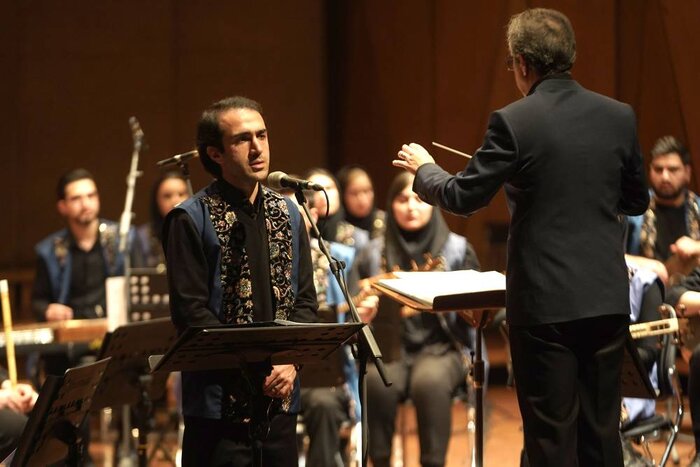
The performance of the Sepehr Iranian Instruments Orchestra at the 40th Fajr International Music Festival was a source of pride for every Iranian. It was a night in which young musicians—deeply rooted in their culture, fully understanding it, and keeping it alive—brought to life the beauty and richness of Iranian music.
On the third night of the festival, the Sepehr Iranian Instruments Orchestra performed at Rudaki Hall. This orchestra is affiliated with the Sepehr Institute of Contemporary Knowledge in Isfahan, which has been training talented students in Persian instrumental performance since 2015. By providing a space for learning and research, this institution has played a significant role in the development and expansion of Iranian music, particularly in the Isfahan province.
Formed in 2021 by the efforts of Sepehr’s professors and students, the orchestra performs a wide variety of Iranian repertoire using traditional national instruments. Its diverse instrumental makeup and distinctive timbre have become defining features.
The instruments performed last night by the orchestra’s young players included tar, tar-bass, santur, bass santur, setar, ney, tombak, oud, and kamancheh. This diverse orchestration not only created a unique sound palette but also showcased the great potential of Iranian music in ensemble and orchestral formats. Together, the instruments created a rich and cohesive sonic atmosphere, reflecting the musicians’ skill and dedication.
The repertoire selected for the evening featured works that offered innovative approaches to Iranian music and its orchestral possibilities. One such example was “Badeh-ye Shabgir” by Hamid Motebassem, originally performed by the Dastan Ensemble in the album “Be Yad-e Nowruz”.
Another highlight was “Raz o Niyaz” from the album “Fasl-e Baran” by Majid Derakhshani, a piece that fused intricate melodies with poetry to create a deep emotional experience. The performance also included “Zarbi-e Homayoun”, composed by Saeed Honarmand, which used different sections of the Homayoun mode to showcase the ensemble’s and the singer’s abilities in improvisation and vocal-instrumental dialogue.
The concert opened with a duet between a tombak and a tar player. Their performance, both synchronized and expressive, served as a fitting prelude to the full orchestral presentation. From the beginning, it promised a night deeply rooted in Iranian tradition and set the tone for what followed.
After the duet, silence briefly filled the hall. Moments later, the full orchestra gradually entered the stage, taking their places behind their instruments. A murmur rippled through the audience but quickly faded as conductor Hamed Younesi stepped in front of the ensemble.
Younesi observed the musicians carefully, raised his hands, and with a single motion, the music began. The first piece emerged with harmony and freshness. The young performers—aged between 18 and 25, according to the orchestra director—played with intense focus and precision.
As the concert progressed, the orchestra’s color and texture became increasingly vivid. The tars played delicately, the kamanchehs responded with lyricism, the ney resonated with soothing melodies, and the tombaks held the rhythm firm. The musicians followed the conductor’s cues with exemplary cohesion.
As the first piece came to a close, the music gradually softened and faded. The hall returned to silence before it was broken by soft applause—regrettably from only around 38 audience members. Despite the small turnout, the response made clear that the performance had been deeply appreciated.
The young musicians performed far beyond expectations. Throughout the concert, it was evident they were not just playing notes—they were immersed in the experience. Eyes closed, fully engaged, they connected with the music and one another in moments of pure artistic sincerity.
What a moving sight it was! The pleasure of listening to authentic Persian music, of watching these devoted and deeply rooted Iranian youth performing with such soul, was an unforgettable experience. The performance was visually captivating as well—there was hardly a blink among the audience during the show.
There were touching moments when players enjoyed their fellow musicians’ solos with closed eyes, before returning attentively to their own instruments and the conductor’s cues. It must be emphasized that this was not a local ensemble but a fully formed orchestra—where coordination, discipline, attention to the conductor, and a shared understanding of the music are essential. These principles were fully realized in this performance.
The music, the Iranian faces, the culturally respectful attire, all reinforced the idea that this was more than a concert. It was a performance—a work of art that, at times, rose naturally to a pure and powerful form, born not from theatrics but from the organic unity of the entire orchestra.
With every moment, the concert inspired pride in being Iranian. It reminded us of who we are and what we possess. What greater honor can an orchestra achieve than leaving such a lasting mark on the hearts of its listeners? And more heartening still is the fact that this entire display of artistry came from youth aged 18 to 25. Even more admirable is that these young people are living with love and commitment to their culture, fully understanding it, and keeping it alive with heart and soul.
As for the conducting, it was clear that the musicians had a strong rapport with their leader and followed him closely. However, a critique worth noting is that the conductor frequently mouthed words to the players, which came across as awkward. Ideally, a conductor should let their hands do the talking. At times, he was even seen counting beats—an action that could have a negative educational effect and encourage undesirable habits.
In the vocal segment, Javad Mousavi delivered a warm and captivating performance, with clean and controlled ornamentation that created powerful moments and conveyed the music’s emotions effectively.
In summary, the performance was not flawless—but perfection isn’t the measure of true artistry. There is still room for greater orchestral cohesion. Yet these small imperfections added a touching sincerity to the performance, deepening its emotional impact. It brought to mind the old saying: In art, perfection is not a virtue.
At the end of the concert, Younesi shared a noteworthy detail—the musicians had traveled from Isfahan to Tehran that very morning, braving snow and fog, and arrived at the hall with only a slight delay. Despite the exhaustion, they performed a heartfelt, nearly flawless concert—and astonishingly, they were to return to Isfahan immediately after the show. This raises an important question: why are such conditions imposed, which not only affect performance quality but also fail to honor the dedication of these young artists?
Even more disappointing was the fact that these talented and passionate musicians—guests of Tehran from Isfahan—played to a mere 38 people at a major national festival. This is a serious critique of the festival organizers, who failed to provide the visibility and audience such a performance deserved. Compared to the National Iranian Orchestra’s concert two nights prior, this performance was humbler, purer, more intimate, and more inspiring. One might even say this group fulfilled the mission of the National Orchestra more successfully than the National Orchestra itself—yet sadly, they did not receive the recognition they so richly deserved.
Written By Farid Parish
